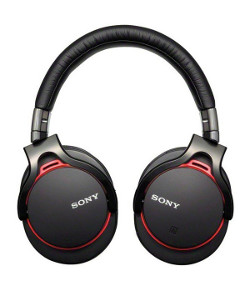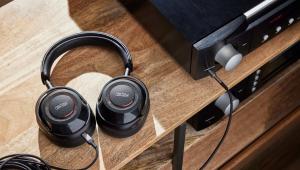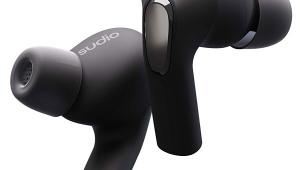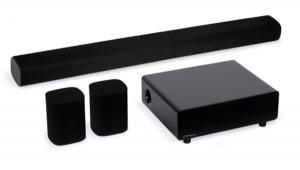Sony MDR-1R Headphone

AT A GLANCE
Plus
Sweet mids, solid bass
Super comfortable
Sporty look
Minus
Reticent highs
Plastic construction
THE VERDICT
These full-size headphones are comfortable, sweet sounding, and suitable for portable signal sources.
Some companies jump into the now-trendy headphone category on a wing and a prayer. Sony, on the other hand, is the steward of Sony Music and the master of numerous audio product categories, including a long history in headphones. So a set of midpriced ’phones from Sony raises high hopes. With the MDR-1R, they are largely fulfilled. I like these headphones, not because they’re perfect, but because they feel right.
The feel starts when you put them on your head. These over-the-ear headphones are extremely comfortable, with leather pads that feel soft and pleasant and a broad padded headband that’s easy on the noggin. They do not clamp down hard or pinch any part of the ear (mine, at any rate).
Aside from the metal piece inside the headband, most parts are plastic. The grumpy consumer might want his three hundred bucks to buy more metal parts, but the plastic does keep the weight down, and it has a shiny metal-like finish that complements the red accent ring.
The headphones fold into a flat shape for storage in a leather-accented woven plastic pouch. They come with two 49-inch cables, terminated at both ends with mini-plugs, a straight one that attaches to the left earpiece, and a right-angled one that plugs into the source device. One cable has a volume control and mike; the other is plain.
Sony pursued “made for” Apple status, and the packaging specifically limits compatible devices to iPhones 4S, 4, and 3GS; the first three generations of iPad; iPod touch gens two through four; iPod nano gens four through six; iPod shuffle third and fourth gen; and the 2009 iPod classic, both 120 and 160GB. If your iOS gear isn’t on that list, you might want to test the functionality of the mic cord before buying.
Under the hood are 40mm liquid crystal polymer film diaphragms. Impedance is 24 ohms, efficient enough to run off your flea amp of choice. My iPad 2, second-gen iPod touch, and fifth/sixth-gen iPod nanos had no trouble running the headphones to satisfying volumes at about two-thirds of their capability (I keep the volume limiters at max).
 Midrange and bass are what these headphones do best. The mids are smooth and golden. The top end is a little rolled off, de-emphasizing cymbal smashes and other high-frequency finery—though this is perfectly acceptable in a device optimized for mobile devices and perhaps for lossy audio files. Likewise, the firm and tuneful bottom end gets the most out of a flea amp.
Midrange and bass are what these headphones do best. The mids are smooth and golden. The top end is a little rolled off, de-emphasizing cymbal smashes and other high-frequency finery—though this is perfectly acceptable in a device optimized for mobile devices and perhaps for lossy audio files. Likewise, the firm and tuneful bottom end gets the most out of a flea amp.
In addition to the iDevices, I also spent some time listening to these headphones through a Woo Audio WA6 headphone amp as well as the headphone output of my reference receiver, the Pioneer Elite VSX-53. They didn’t need the extra gain afforded by the headphone amp; I toggled the impedance switch to compensate. Nor did they make much of a distinction between the tube headphone amp and the solid-state receiver. The Woo was just a tad more sensuous and refined in the mids and highs. My other headphones have a stronger preference for the Woo. If you’re looking to access top-end revelations through high-end ancillary gear, these aren’t the headphones for you—though they never sounded less than musical and I took pleasure in them no matter what other equipment I used.
Relative to the two headphone models I rely on the most, the Sony held its own, while asserting its warm and rich personality. When fed by a good amp, the AKG K240 had stronger imaging, soundstaging, and overall fidelity; the Sony was comparatively blurred at the top and heavier at the bottom. However, when running off mobile devices, the Sony did a better job of holding onto its good qualities, whereas the AKG tended to get sludgy. The first-gen Bose TriPort had a more objective balance of frequencies and, again, stronger imaging, but its midrange was schematic compared to the better-fleshed-out treatment of the Sony, and I had to play it at a lower volume.
I hesitate to say that the Sony MDR-1R is not an audiophile product. While it’s not suitable for a high-end head-fi system, it is brilliant at its chosen mission of making mobile devices sound as smooth and listenable as possible. I plan to get a lot more casual use out of my pair. Feeling good is good.
Incidentally, these headphones come in three versions: plain, Bluetooth, and noise-canceling. The plain model is the one reviewed here and the only one assessed for sound quality.
Specs
Type: Closed-back, over-ear
Driver Size: 1.5 inches (40 mm)
Impedance: 24 ohms
Weight: 8.47 oz
Price: $300 (Bluetooth version, $400; noise-canceling version, $500)
- Log in or register to post comments





































































